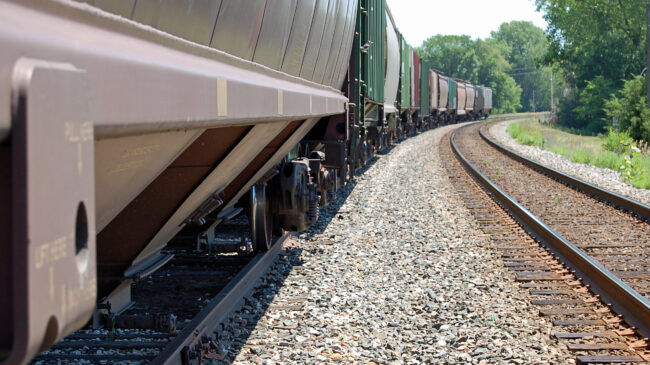On March 15, the Surface Transportation Board held a hearing on a 2016 regulatory proposal that would amend agency policy for mandating a practice known as reciprocal switching. The purported aim is to combat alleged rail carrier market dominance and reduce shipping rates for the benefit of industrial and agriculture customers. Most of the debate has focused on questions of market power and short-term shipper benefits, but one subject largely ignored is arguably the most important: the long-term impact of the rule on freight rail innovation and the viability of the mode itself.
Reciprocal switching refers to a practice where one rail carrier exchanges the car(s) of another in order to allow a customer access to a facility served by only one carrier. This allows the competing carrier to offer single-line service to the customer even though its track does not physically reach a customer’s facility.
Railroads voluntarily enter reciprocal switching agreements when it makes sense. Under current rules established in the 1980s by the (now defunct) Interstate Commerce Commission and affirmed by federal courts, the Surface Transportation Board (STB) can only impose reciprocal switching if anticompetitive conduct on the part of a rail carrier has been demonstrated.
Most significantly, the proposed rule would eliminate the anticompetitive conduct requirement with the goal of forcing more carriers into reciprocal switching arrangements. The stated rationale for doing this was that shippers have failed to prove any anticompetitive conduct on the part of rail carriers. Is anticompetitive conduct too difficult to prove or is such conduct not occurring? The STB accepted the former hypothesis without seriously probing the latter.
One curious aspect of the Surface Transportation Board’s concern about railroad market power is that its own research does not support it. The STB’s most significant analytical undertaking on this topic was to commission a study from economic consultants Laurits R. Christensen Associates. The revised 2010 Christensen Associates study concluded that “increases in the railroads’ generic costs […] were driven primarily by the spike in fuel prices in recent years. Thus, while shippers have been exposed to increasing [railroad revenue per ton-mile] after 2004, it appears that costs rather than markup factors are largely the culprits.”
The U.S. railroad industry of 2022 looks quite different than the industry of 2008, the last data year of the Christensen Associates revised competition analysis. Most strikingly, the sharp decline of coal-fired electricity generation has led coal-by-rail tonnage to decline by nearly half since 2008.
The STB in December released its Annual Rail Rate Index Study (the first since 2009), which adds 12 years of data through 2019. A February update added 2020 rates. These are valuable new data, but as former STB chief economist William Huneke noted while calling for an update to the Christensen study, rate data alone cannot support the allegations of undue exercise of market power. “To implement more regulation without a better understanding of the industry’s financial health is akin to taking a deeper dive without checking the water depth,” said Huneke.
The proposed rule is also anticipated to increase operational complexity, which could be especially destructive during today’s unprecedented logistics network congestion and global supply chain uncertainty. The Association of American Railroads provides an example where switching a single railcar required 68 locomotive operations, the use of three switching yards, and six days to complete. While typical switching operations under the proposed rule may be less complex and costly, the STB cannot confidently say that they will be. This is why major freight rail customer UPS and passenger carriers that share freight-owned track (such as Amtrak and Chicago’s Metra) have opposed STB’s proposal.
Finally, an increase in mandatory reciprocal switching could reduce the long-term competitiveness of freight rail relative to trucking. In early February, Union Pacific and automated truck developer TuSimple announced a partnership to launch a fully automated 80-mile truck route from a Tucson rail yard to a Phoenix-area distribution center. This technology has the potential to cut truck operating costs by nearly half and lead to the development of “road trains.” These coordinated convoys of driverless trucks have the potential to greatly reduce rail’s traditional volume advantage over trucks for numerous commodity groups.
Unsurprisingly, railroads are interested in a variety of automation technologies to improve safety, productivity, and their competitive standing with other modes that are anticipated to become increasingly automated. Train automation is likely to be incremental as functions are gradually automated and personnel are relieved from certain tasks once safety is assured. But fully automated freight trains may be on the horizon, as mining giant Rio Tinto Group successfully demonstrated in a 2019 deployment of 240-car iron ore trains in Western Australia.
Unfortunately, the STB’s proposed regulations on reciprocal switching would likely negatively impact railroads’ returns on investment, thereby reducing their incentive to invest in train automation research, development, and deployment. Tom Wadewitz, then a managing director at J.P. Morgan Securities, pointedly warned the STB at a hearing more than a decade ago that investors will pressure railroads to reduce capital expenditures if the STB adopted any regulations that “negatively affect pricing.” And it is generally research and development of unproven technologies that gets axed first when shareholders throttle capital expenditures to maintain their desired returns on investment.
The STB should avoid disadvantaging freight rail relative to its modal competitors, which would incentivize customers to shift traffic from rail to trucks. This would have private as well as social costs. When compared to freight rail, the EPA estimates trucks emit 10 times as much carbon dioxide per ton-mile and more than three times as much particulate matter. Pushing even a small share of freight rail traffic onto the highways would increase the transportation sector’s air pollution emissions intensity.
To assure a balance in favor of the public interest, the Surface Transportation Board should not amend its reciprocal switching regulations until it can credibly show that the benefits would exceed the costs. Moving forward absent this evidence would undermine its credibility. The STB’s authorization lapsed at the end of FY 2020 and Congress should pay close attention as it considers reauthorization.
A version of this column first appeared in Eno Transportation Weekly.

